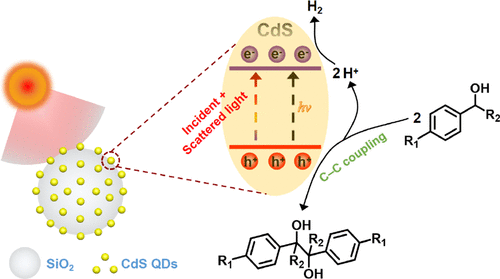当前位置:
X-MOL 学术
›
ACS Catal.
›
论文详情
Our official English website, www.x-mol.net, welcomes your
feedback! (Note: you will need to create a separate account there.)
Efficient Photoredox-Mediated C–C Coupling Organic Synthesis and Hydrogen Production over Engineered Semiconductor Quantum Dots
ACS Catalysis ( IF 11.3 ) Pub Date : 2020-11-23 , DOI: 10.1021/acscatal.0c04237 Ming-Yu Qi 1, 2 , Yue-Hua Li 1, 2 , Masakazu Anpo 1, 3 , Zi-Rong Tang 2 , Yi-Jun Xu 1, 2
ACS Catalysis ( IF 11.3 ) Pub Date : 2020-11-23 , DOI: 10.1021/acscatal.0c04237 Ming-Yu Qi 1, 2 , Yue-Hua Li 1, 2 , Masakazu Anpo 1, 3 , Zi-Rong Tang 2 , Yi-Jun Xu 1, 2
Affiliation

|
Photocatalytic hydrogen (H2) evolution coupled with selective organic synthesis over semiconductor-based photocatalysts is attractive because the clean H2 fuel and value-added chemicals can be coproduced at ambient conditions using solar light as the sole energy input. Here, we report the efficient merging catalysis of photoredox-driven dehydrogenative C–C coupling of benzyl alcohol (BA) into hydrobenzoin (HB) and H2 evolution over the SiO2-supported semiconductor CdS quantum dots (QDs) at ambient temperature and pressure. In this system, we utilize the judicious interfacial engineering approach to rationally assemble CdS QDs onto the spherical SiO2 support by which CdS QDs can recycle the scattered light in the near field of SiO2 and achieve the significantly enhanced light-harvesting capability and more efficient generation of charge carriers. Consequently, as compared to bare CdS QDs and Pt/SiO2, the SiO2-supported CdS QDs (CdS/SiO2) exhibits distinctly boosted photoredox-catalyzed activity and stability for C–C coupling of BA into HB and H2 evolution. The underlying origin toward an efficient C–C coupling reaction over CdS/SiO2 is analyzed accordingly. This work would open a conceptual vista of utilizing a near-field scattering-promoted optical absorption model and nanoscale interfacial assembly method to maneuver the light-capturing property of semiconductor QDs without size alteration for solar fuel production and organic synthesis of fine chemicals.
中文翻译:

工程半导体量子点上有效的光氧化还原介导的C–C耦合有机合成和产氢
光催化氢(H 2)的释放与基于半导体的光催化剂上的选择性有机合成相结合是有吸引力的,因为可以在环境条件下使用太阳光作为唯一的能量输入来联合生产清洁的H 2燃料和增值化学品。在这里,我们报道了在环境温度和压力下,由SiO 2支撑的半导体CdS量子点(QDs)上的光氧化还原驱动的苄醇(BA)的脱氢CC偶联成氢安息香素(HB)和H 2的高效合并催化。。在该系统中,我们利用明智的界面工程方法将CdS QD合理地组装到球形SiO 2上CdS QD可以通过这种支持来再循环SiO 2的近场中的散射光,并显着增强光收集能力并更有效地产生电荷载流子。因此,与裸露的CdS QDs和Pt / SiO 2相比,SiO 2负载的CdS QDs(CdS / SiO 2)表现出明显的光氧化还原催化活性和BA到HB和H 2演化的CC连接的稳定性。在CdS / SiO 2上进行有效的C–C偶联反应的根本原因进行相应的分析。这项工作将打开一个利用近场散射促进的光吸收模型和纳米级界面组装方法来操纵半导体量子点的光捕获特性而无需改变尺寸即可用于太阳能燃料生产和精细化学品的有机合成的概念远景。
更新日期:2020-12-04
中文翻译:

工程半导体量子点上有效的光氧化还原介导的C–C耦合有机合成和产氢
光催化氢(H 2)的释放与基于半导体的光催化剂上的选择性有机合成相结合是有吸引力的,因为可以在环境条件下使用太阳光作为唯一的能量输入来联合生产清洁的H 2燃料和增值化学品。在这里,我们报道了在环境温度和压力下,由SiO 2支撑的半导体CdS量子点(QDs)上的光氧化还原驱动的苄醇(BA)的脱氢CC偶联成氢安息香素(HB)和H 2的高效合并催化。。在该系统中,我们利用明智的界面工程方法将CdS QD合理地组装到球形SiO 2上CdS QD可以通过这种支持来再循环SiO 2的近场中的散射光,并显着增强光收集能力并更有效地产生电荷载流子。因此,与裸露的CdS QDs和Pt / SiO 2相比,SiO 2负载的CdS QDs(CdS / SiO 2)表现出明显的光氧化还原催化活性和BA到HB和H 2演化的CC连接的稳定性。在CdS / SiO 2上进行有效的C–C偶联反应的根本原因进行相应的分析。这项工作将打开一个利用近场散射促进的光吸收模型和纳米级界面组装方法来操纵半导体量子点的光捕获特性而无需改变尺寸即可用于太阳能燃料生产和精细化学品的有机合成的概念远景。











































 京公网安备 11010802027423号
京公网安备 11010802027423号